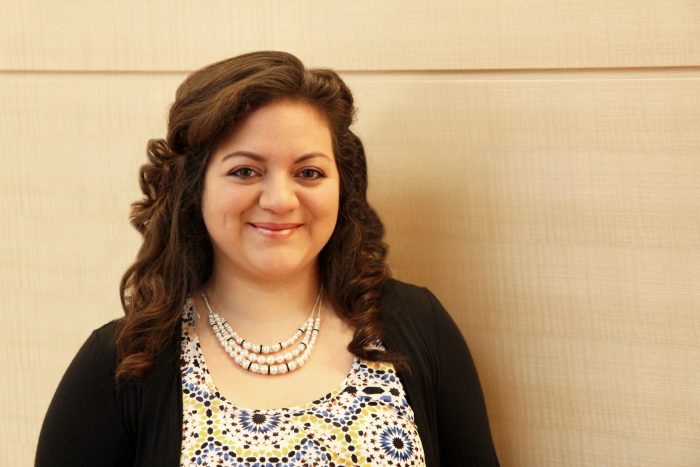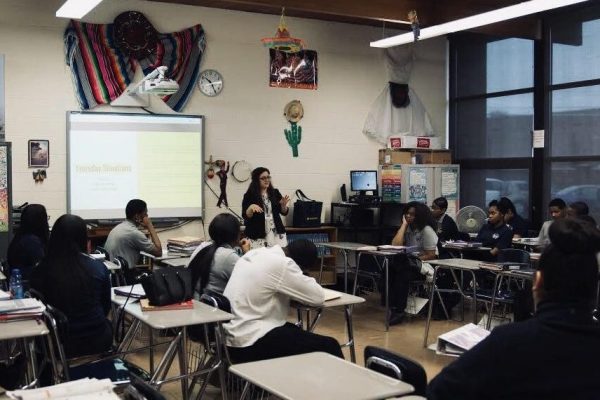
Marissa Taylor is a program manager of communication and technology at the Center for Educational Outreach. (Emma Holmes)
Michigan IT News recently interviewed Marissa Taylor about her work for the Center for Education Outreach (CEO) within the Office of Diversity, Equity, and Inclusion (DEI). Taylor, now a program manager of communication and technology at the CEO, began her career in IT three years ago when she was a graduate student at the U-M School of Information (2015). Her background and education give her a valuable perspective to bring to the CEO as she understands what underrepresented communities need when it comes to technology and access.
In May 2018, you were awarded a Certificate of Appreciation for your work for the Center for Educational Outreach. Tell us a little about that.
Each year, the CEO has a partner appreciation lunch to say thank you to everyone they worked with during the last year. In addition to this, they give out three awards to their partners who went above and beyond. Last year, I was given the Certificate of Appreciation for my work with Wolverine Express and Youth Hub. Wolverine Express brings U-M faculty and staff to Michigan high schools to share their stories to inspire students. Youth Hub is a one-stop shop for K-12 students to explore opportunities at the University of Michigan without having to go to multiple websites to find something they would be interested in.
What does the Center for Education Outreach do?
As part of the Office of Diversity, Equity and Inclusion, the Center for Educational Outreach supports and advances the University of Michigan’s commitment to educational outreach and academic excellence. The CEO partners with faculty, staff, and students to develop and implement programs that inform, engage, and inspire a diverse community of scholars.
You recently began a new position as the CEO Program Manager of Communication and Technology within the Office of Diversity, Equity, and Inclusion. Tell us a little about your new role and the responsibilities you’ve taken on.
The CEO offers multiple programs to promote college access and college readiness to K-12 students (and consults the schools and colleges around U-M on how to do their own program well). As the program manager of communication and technology, I work with the CEO director to form and promote the CEO brand around the university and to our outreach community partners throughout the state of Michigan and across the country. I also partner with the other program managers to incorporate technology into their programs. For example, I actively promote the use of Google Forms, Qualtrics, Tableau, and Salesforce in CEO to streamline our communications and program feedback analysis. I also support and train CEO staff on technological tools, and design-thinking methods to enhance and streamline current programming methods. Our goal with this training is to limit administrative burdens and encourage the adoption of technological best practices that promote a transparent team culture to leverage the team’s strengths and institutional knowledge.
You’ve been involved with the Center for Education Outreach for a while, what keeps drawing you to it?
The mission behind CEO. I’m a proud Latinx first-gen student from a low socio-economic background and the first in my family to go to college. My mentors encouraged me to do the impossible, and my life and my family’s life will be forever changed. Through CEO, I am able to inform, engage, and inspire students with my story and CEO’s resources.
How do you see the role of IT furthering U-M’s DEI efforts?
One role IT plays in furthering the DEI vision at U-M is accessibility. Not just in regards to making sure what we design is accessible by various different devices, but also the concept of how people access the great resources of U-M. For example, many of our faculty want to work in under-resourced communities and are surprised at times when they show up with a presentation, but the school’s technology doesn’t work or the WiFi is down. These are IT luxuries in some communities we take for granted. However, IT can still partner to make things happen. Using your phone plus data, a phone projector, and a Bluetooth speaker is all one needs to always be able to do a presentation. When IT overcomplicates the accessibility situation, others do not adopt the best practices. My ideal IT mission is being mindful of the user’s situation, and figuring out what works best for them while still empowering everyone to be more accessible with small, easily adopted adjustments.
Do you see communication/technology as having a positive or negative effect overall on DEI in general?
A negative effect communication/technology have on DEI is overloading users with information. However, communication/technology that is mindful in finding their target audience, reaching out with new information and/or opportunities, and telling people the impact of their time is powerful. One of the things I’m designing for our next Partner Appreciation Luncheon is a digital infographic of the impact of CEO over the last year. This will show our volunteers the overall impact of their time and energy, whereas, in the past, one would just know their impact based on their side of an experience.

Marissa Taylor shares her education and career experiences to a room of high school students during a Wolverine Express session.
What’s one thing about your job that you wish more people knew?
A fantastic benefit of the UMSI MSI degree is being a lifelong learner. I may not know a particular software, but give me an hour and I’ll figure out most of what I need to know. Also, the design thinking method of finding solutions and core problems is game-changing. I wish more people at the university would pursue an MSI degree because I believe the whole university would be elevated to the next level. I also would like people to know that CEO has so many different opportunities for them to volunteer their time in the community. I would love to connect with you about sharing your story on the next Wolverine Express trip!
How does the work you do impact the greater university community?
We offer wonderful public engagement opportunities for U-M faculty and staff and students to share their story and enhance their research and community impact around the state of Michigan.
Is there an IT-related project of which you are particularly proud that you’d like to highlight?
Youth Hub is our website that serves as a one-stop place for all K-12 students, parents, and educators to view all opportunities U-M offers during the summer and throughout the school year. We are in the process of working with InfoReady to create an app for students to use that will match them with U-M opportunities. This helps navigate students throughout the university with ease and confidence.
Anything else you’d like to share about how your role in IT helps further the mission of U-M?
There is a larger discussion about centralized data and a different conversation about public engagement occurring at the university right now. Part of my role as being both in IT and in public engagement (and DEI), is to connect these conversations. I’ll be in a public engagement conversation and remind people to take into account that technology is not magic—it still needs to make sense. Same with DEI, defining what DEI means on a data level is incredibly powerful when it comes to reporting and metrics for success, as opposed to just a feel-good pulse number. From my perspective, IT, public engagement, and DEI are the next key partnerships ready to take place at the university, and I’m excited to see how U-M enhances their community impact over the next decade.
